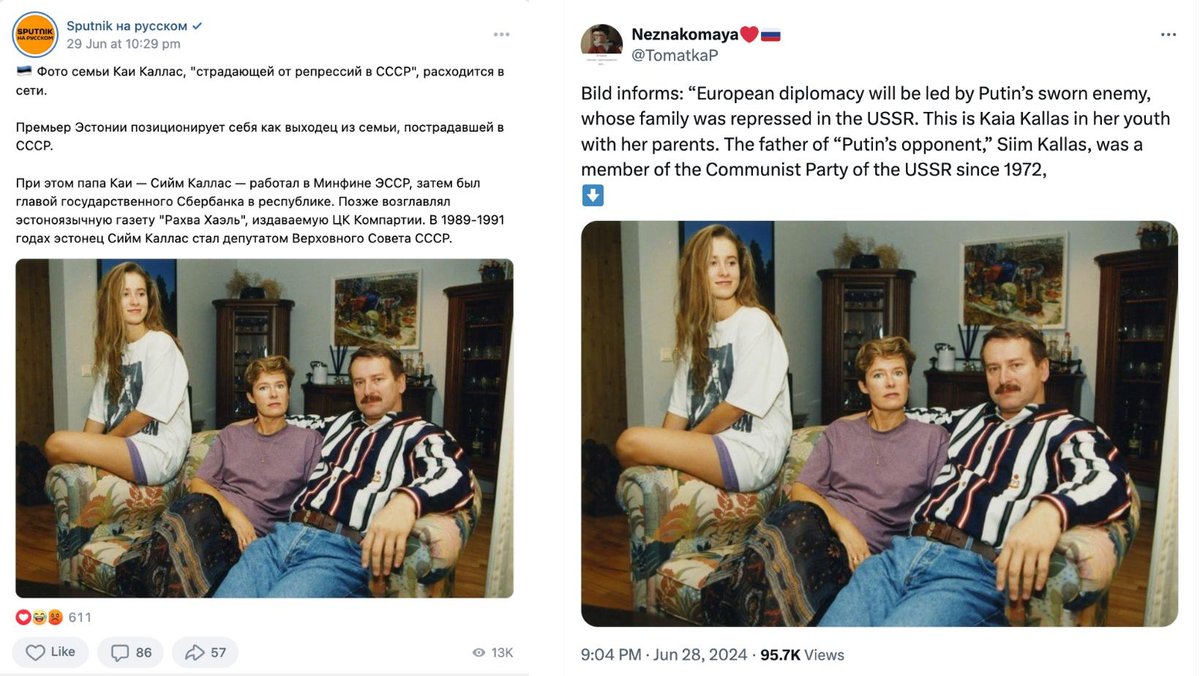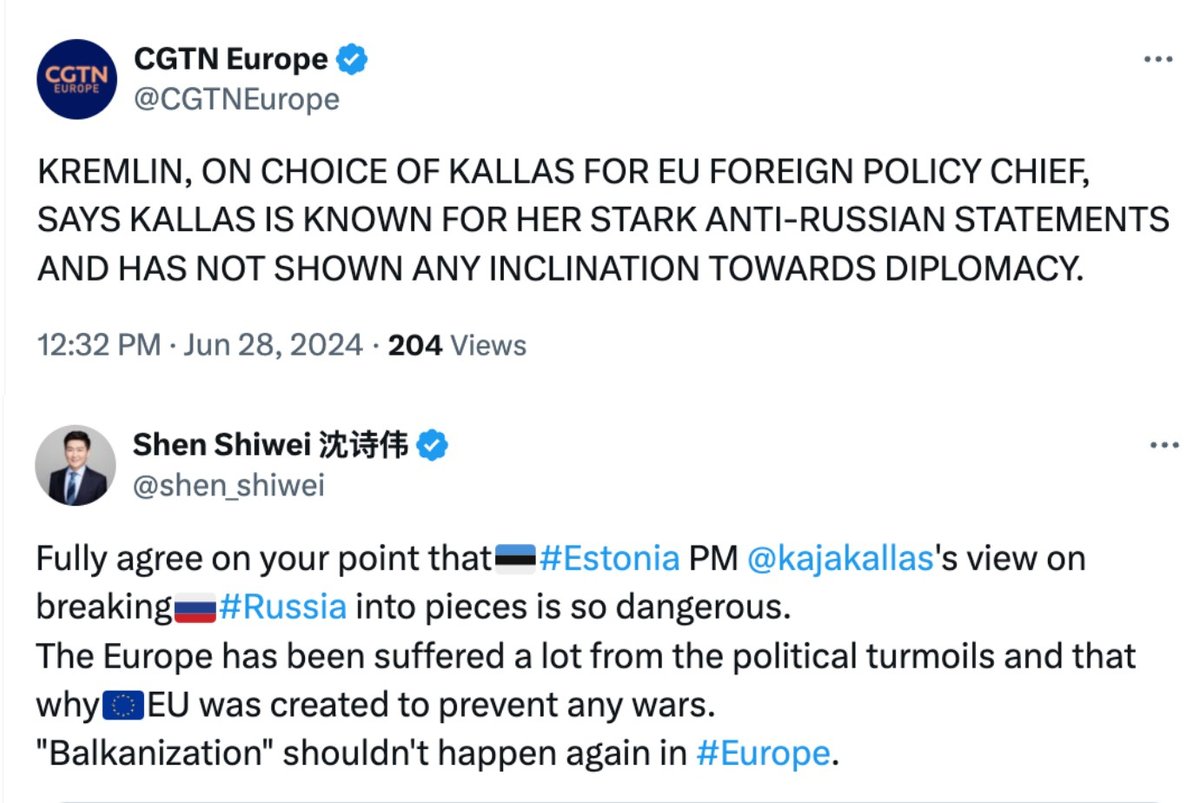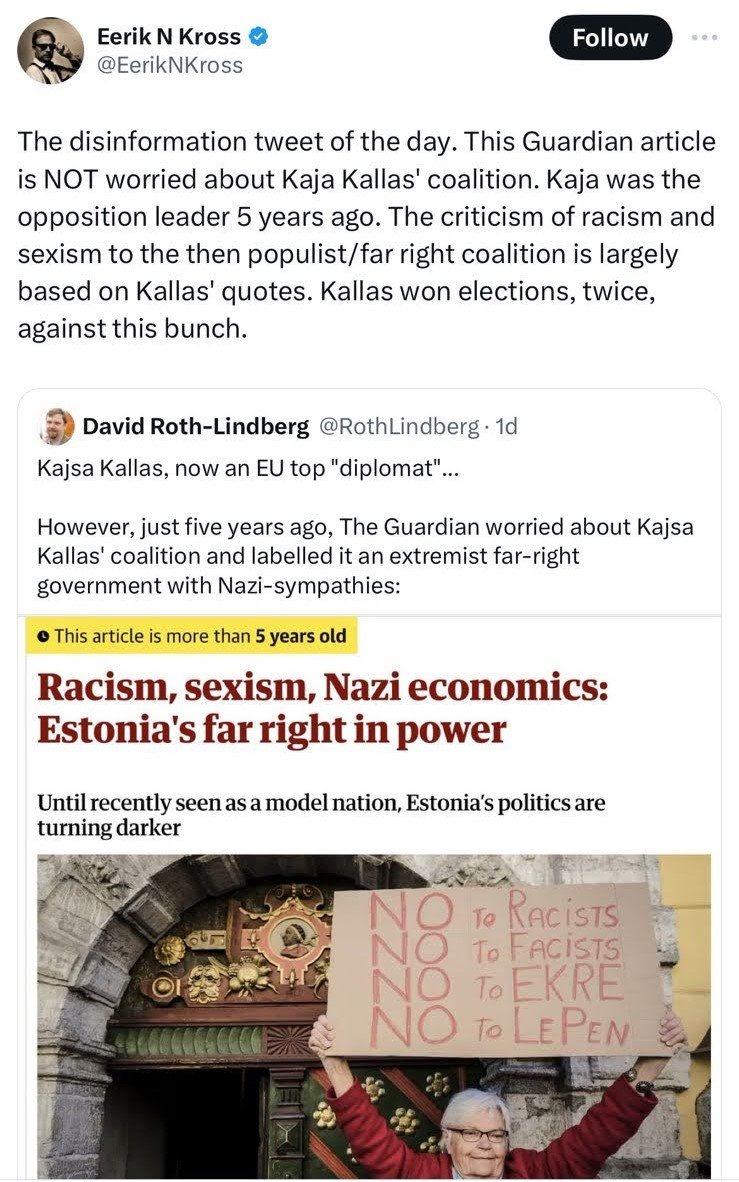This article was originally published by Eesti Päevaleht
Last Thursday, it was revealed that the European Council nominated Kaja Kallas as the candidate for the High Representative of the European Union for Foreign Affairs and Security Policy. After that, the Kremlin started a larger disinformation campaign against Kallas on social media.
The most popular false claim currently circulating is related to a photo of teenage Kaja Kallas. She has repeatedly talked about how her grandparents and mother were deported to Siberia by the Soviet authorities, referring to the horrors that Estonians had to go through at that time. The photo of Kallas sitting next to her parents as a “well-off” teenager is now used by pro-Russian disinformation as “proof” that life was beautiful at that time, Kallas was lying and there was no repression [Greece Fact Check, another organization from the EDMO fact-checking network, helped Eesti Päevaleht in verifying that the post in question was disinformation].
The photo is taken after Estonia regained its independence
The photo currently circulating virally on social media is from 1994-1995, after Estonia became independent from the USSR in 1991, and the furniture in the picture is from the 1930s, according to Kaja Kallas. “It has been preserved by my other grandmother (not the one who was deported to Siberia) and it shows that Estonia was a prosperous country before the Soviet occupation,” she wrote in a post on X. The time of the photo is also indicated by the light switch visible next to her hand in the photo. Such switches were not used in Soviet times.
This photo of young Kaja Kallas with her parents appeared to a wider audience for the first time in 2019, when Elu24 and Limon published news about the “Retro Throwback” and showed old photos of the young Kallas. Later, the photo has been innocently circulated in various social media groups. Now Russian propaganda has found it.
Delfi’s research revealed that the false information campaign against Kallas was launched at the same time by the Russian propaganda network Sputnik on their VKontakte page in Russian and by the account of X user “Neznakomaya” one day after the candidacy of Kaja Kallas was announced, on the evening of June 28.

“Russia is not between the West and the East. Only the West and the East are to the left and right of Russia!” it says in the account description of “Neznakomaya” aka “unknown”. The username has emoticons of a red heart and a Russian flag next to it. He massively distributed pro-Russian and anti-Ukrainian false information. His Kallas post began to be shared by similar accounts that adorn themselves with Russian flags, hearts, and references such as #standwithrussia.
The photo of “Kallas suffering from repression” was then spread in dozens of Russian online publications and Telegram channels, the most popular posts appeared on OstashkoNews with almost 390,000 followers and Zergulio with about 350,000 followers. Both are big mouthpieces of Russian propaganda.
For the narrative to move more forcefully out of Russia and into Europe, well-known Russian propaganda networks, like Pravda and InfoDefense launched an extensive false information campaign in at least ten different languages, including Estonian.

Already in the very first posts and on Russian state propaganda channels, Kaja’s name changed to Kaya, Kai, or Kaia. If you translate “Kaja Kallas” from Estonian to English using Google Translate or Deepl’s automatic translation, the spelling will not change. If you translate “Кая Каллас” from Russian into English, the spelling changes into “Kaya Callas”. Just such “printing errors” were characteristic of all the subsequent, as if natural, spread and amplification of information.
A photo of young Kaja Kallas conquered X
The photo of the young Kallas, with the false claim that it was taken during the Soviet era, began to circulate more actively on the pro-Kremlin X English-language channels on June 30.
“It is known that the myth of the ‘Soviet occupation’ is being cultivated in Estonia, according to which the stay of the Estonian SSR within the Soviet Union was decades of darkness and horror,” wrote for example X user @ivan_8848, sharing the photo and receiving nearly 877,000 views to date. This profile consistently spreads pro-Kremlin content and false information about Ukraine, Europe and NATO.
At the same time, similar posts appeared on numerous popular pro-Russian X channels. The nine most popular posts in English, Russian, Spanish, and German received a total of nearly 1,800,000 views.
Below the posts there are hundreds of comments, and a large number of them seem to be produced by trolls and bots: users who produce comments are not associated with an authentic name or face, their usernames have a similar structure – a short word or name with any combination of numbers. Many profile pictures are fake. The style, language, and content of the comments are similar. Not to mention that dozens of posts appear on their wall every hour 24/7, and a large number of them follow and amplify each other’s accounts.
The classic Nazi story – another lie about the Kallas family
The false information about the photo of the young Kaja Kallas is part of Russia’s general propaganda narrative that there was allegedly no repression during the Soviet era and that the “big friendly alliance”, USSR, instead helped Estonia get back on its feet.
Russian propaganda, specifically about Kaja Kallas and her family, is distributed consistently. For example, last May, an hour-long program was dedicated to Kallas on Russian state television to talk about how much of a “Russophobe” she is: “Even though her youth was spent in the friendly Soviet Union, in whose nomenclature his father worked.”
When Russia declared in February that Kaja Kallas was put on the most-wanted list, the Russian media published numerous articles to explain the “necessity” of this move. For example, in the article titled “How a Communist’s Child Became a Russophobe”, the narrative is repeated that Kallas has become a “Russophobe” and thereby betrayed her roots.
Last year, Eesti Päevaleht got a hold of documents that show how the network of the notorious Russian oligarch Yevgeny Prigozhin planned to organize influence campaigns in Estonia. One of the goals was to attack Kaja Kallas through her father Siim Kallas and her ex-husband, Elering’s former board chairman Taavi Veskimäe, associating them, for example, with corruption and indicating that Elering, which runs unprofitable projects, is “begging for money from the European Union”.
A year ago, in a Russian TV show, it was claimed that the maternal grandfather of Kaja Kallas collaborated with the Nazis, for which his family was deported to Siberia as a punishment. This is not true. The photo shown in the program shows Siim Kallas’ grandfather Eduard Alver, who was the commander of the Defense League during the War of Independence and died in 1939, i.e. two years before the German occupation. However, Kaja Kallas’ mother was deported with her family to Siberia in 1949, where she spent almost ten years.
Kaja Kallas is also attacked by China at the national media level. For example, China’s state-run English-language media channel CGTN (China Global Television Network) immediately after Kallas’ candidacy was announced, claimed that she had not taken enough diplomatic steps to communicate with the Kremlin.

So far, the Chinese campaign has been unsuccessful, with X’s posts receiving only a few hundred views.
An article in The Guardian from five years ago
Another popular false claim about Kallas is a five-year-old article title from The Guardian, which talks about the growing right-wing extremism in Estonia. The spreaders of this article claim that the government of Kaja Kallas was branded as far-right.
However, The Guardian article is from 21 May 2019. At that time, the second government of Jüri Ratas was in power in Estonia (April 29, 2019 – January 14, 2021), Kaja Kallas was leading the main opposition party, Eesti Reformierakond (Estonian Reformist Party) and she had never led a government previously.

Marta Vunš, Eesti Päevaleht
Kaili Malts, Eesti Päevaleht
Photo: Philippe STIRNWEISS Copyright: © European Union 2022 – Source : EP
